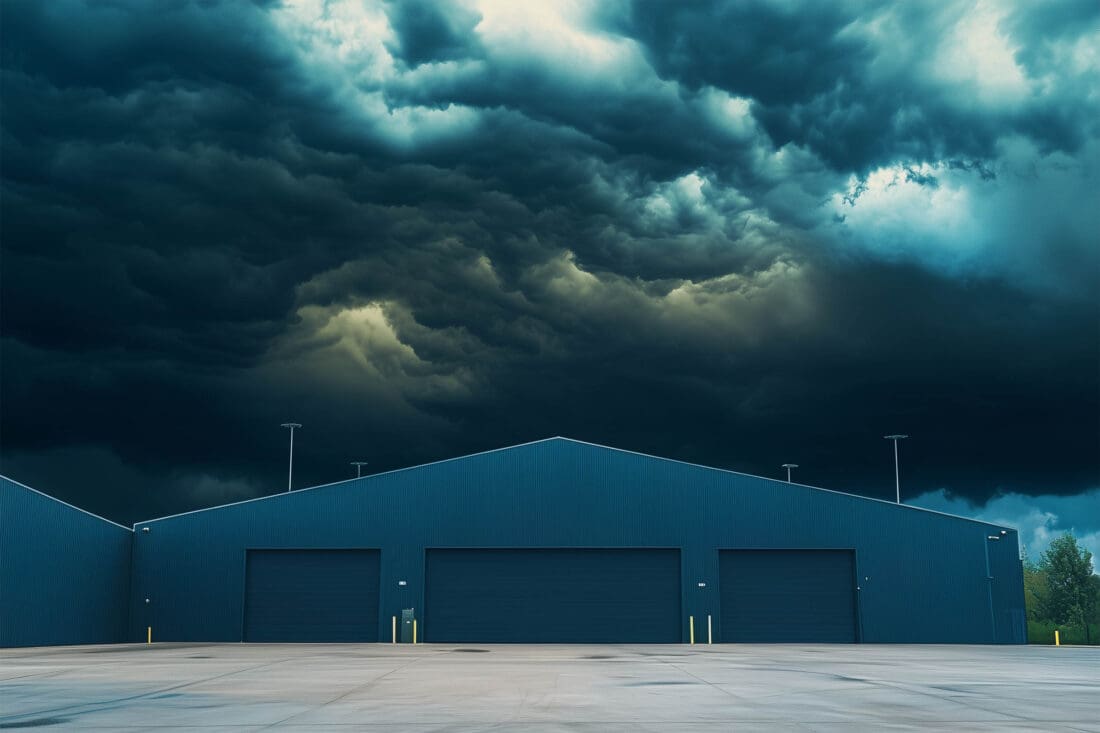Commercial Roofing and Extreme Weather
How Extreme Weather Events Can Affect the Roof of Your Commercial Building—and What You Should Do to Protect Your Assets
North America routinely experiences extreme weather events. From hurricanes in Florida to tornados in Texas to droughts and flooding in California, hazardous weather is a fact of life for all Americans.
In 2024 alone, the United States experienced 27 weather-related events that each caused more than $1 billion in damage, according the National Oceanic and Atmospheric Administration (NOAA).

The year started off with a bang in January, as Winter Storm Finn swept across the Great Plains, reaching as far as New England. The storm brought high winds, snow, hail, and an outbreak of tornados in the deep south, causing a number of fatalities.

In June, Hurricane Beryl whirled into the Gulf of Mexico, making landfall in Texas on July 8. It then veered toward the northeast, reaching as far north as Ontario, Canada as a tropical storm. It was the first of two Category 5 hurricanes to hit the U.S. during the 2024 season.

The second Category 5 hurricane was Milton, which made landfall in Siesta Key as a Category 3, but gained strength as it swept across the Florida peninsula. The storm spawned 19 tornados, knocked down trees and power lines, and caused catastrophic flooding.

In September, Hurricane Helen brought unprecedented flooding to western North Carolina, leaving thousands homeless and causing $47.5 billion in damage.

Meanwhile, areas of the South and West were experiencing drought conditions, even as the Pacific Northwest saw heavy rainfall. Wyoming, the Dakotas, southeastern California, Arizona, southern New Mexico and west Texas all recorded extremely dry conditions through much of the year.
Unfortunately, 2025 doesn’t seem to be providing much of a respite from weather catastrophes.

The wildfires that broke out in Southern California in January, although not caused directly by weather, were exacerbated by low humidity and strong Santa Ana winds blowing in from the Great Basin. The blazes burned more than 58,000 acres, destroyed 16,251 structures, left more than 200,000 homeless, and killed at least 29 people. As happens so often in California, the fires also left the hillsides bare and subject to landslides when the inevitable winter rains hit.

In mid-March, a deadly tornado outbreak hit the South and Midwest, killing ten people in Missouri and three in Arkansas.
These selected examples illustrate the need for Americans in all regions to take weather risks seriously and prepare accordingly. Often, the part of a structure most vulnerable to weather-related damage is the roof. Owners and managers of commercial properties must make preventive roof maintenance a priority. Fortunately, there are specific actions they can take to significantly reduce the risks.
Protecting Your Commercial Roofing from Extreme Weather
Roof damage is typically caused by either of two factors: wind or water.
Strong winds can cause roof uplift, creating damage ranging from minor panel separation to complete dislodging of the roof, as happens in strong hurricanes. This risk is especially prevalent in wind-prone regions such as the Great Plains but can occur anywhere. Roof materials are subject to testing and given ratings based on their weather resistant properties. The UL 580 standard measures a roof system’s wind uplift resistance and assigns classifications of 30, 60, and 90 based on performance. Knowing your roof’s classification and insisting on the best material can provide peace of mind.
Standing seam roof systems include raised vertical seams that conceal the fasteners where leakage could occur, providing excellent protection from water damage.
Frequently Asked Questions:
What are the risks of heavy rain and flooding for commercial roofing systems?
Precipitation and flooding can cause leaks in roof panels, especially at seams and connections. This can lead in turn to interior water damage, electrical problems, and mold growth. Water pooling can also be a serious hazard, causing similar problems as well as collapse of the roof.
What are the most common roofing maintenance mistakes that can make extreme weather damage worse?
The most common mistake—and the easiest to fall into—is failing to schedule an annual roof inspection. That inspection can reveal present damage as well as trouble spots that can cause problems in the future. Displaced shingles, exposed fasteners, and warped roof material can be caught in time to prevent serious problems.
How can I improve the storm resistance of an older commercial roof without replacing it entirely?
When replacing the roof is impractical because of cost or other factors, a roof coating can provide a satisfactory solution. Roof coating systems range from silicone treatment for roofs that are basically in good shape, to spray foam systems, which can enhance water resistance and add R-value.
What steps should I take after extreme weather to assess my commercial roof?
The first step is to conduct a visual inspection, looking especially for damaged tiles, exposed fasteners, warped material, water pooling, and other signs of trouble. Remove any debris and accumulated water, snow, or ice. Then, examine the building’s interior for signs of leakage or water damage. Finally, schedule a professional inspection—and while you’re at it, make that a regularly scheduled event.


